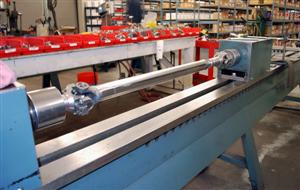February 2010 - Performance Zone
SMOOTH OUT YOUR SEMI
By Performance Specialist Bruce C. Mallinson
If you have been reading my articles over the years, you know that a bad crankshaft damper will fail to suppress torsional vibration. You also know that crankshaft axial vibration can be mitigated by one of our mercury-filled engine balancers. To further reduce vibrations, we also balance all of the connecting rods and pistons that we install in our rebuilt engines. The smoother the engine, the longer the truck will last, the better the fuel mileage, and you, the operator, will not get as tired at the end of the day when driving. We are always looking for ways to make older trucks smoother, more powerful, and more fuel efficient than a new truck. With that in mind, today we are going to talk about another type of vibration caused by another part in your engine – the driveshaft.
I purchased my 1995 Dodge pickup new in late 1994 and have been driving it for the past 15 years. The stock 5.9 Cummins made 160 hp, which was a joke. I never drove it stock. Instead, I cranked it up in the dealer’s shop the evening that I picked it up. I wasn’t worried about the warranty – I just wanted it to go when I pushed on the throttle. At 42 psi of turbo boost, the horsepower is somewhere in the mid 400’s, and after 204,000 miles over 15 years of pulling trailers, I have had no engine failures. Recently, while pulling my enclosed snowmobile trailer, I started to feel a roughness at 25 psi turbo boost when pulling hills. After 15 years of driving the same vehicle, I know this truck. Last winter, after I installed a silicone-filled engine damper, she ran very smooth. Now, I was feeling another vibration, and I knew that it wasn’t the tires because I have Balance Masters mercury-filled balancers on all four tires.
To diagnose the problem, I slid under the vehicle and checked the universal joints, but everything seemed to be tight. I had rebuilt the differential last spring, so I eliminated that. I then removed the driveshaft and took it to Driveline Specialists in Henderson, CO, a division of Western Truck Parts, and they dissembled the shaft, straightened one section, balanced the two shafts, and installed new u-joints and a new carrier bearing (which they felt was my problem). After I installed the driveshaft and went for a test ride, my old girl was as smooth as a new truck. Liking the success they had with my pickup, I went back to Driveline Specialists to ask some questions and watch them rebuild some Class-8 driveshafts.
So I asked the guys at Driveline Specialists, “How many miles will a Class-8 driveshaft last when the truck runs coast-to-coast?” Their answer was about 500,000 miles. Interesting – a crankshaft damper is only good for 500,000 miles and now the driveshaft should also be rebuilt at 500,000 miles. So, for those of you who are still chasing a vibration, even after changing the damper and installing a mercury-filled balancer, you might want to have your driveshaft rebuilt. Western Truck Parts can remove, rebuild and install your driveshaft and you will be amazed (like I was) at how smooth your older truck can be. Their phone number is (303) 287-5538 – tell them Bruce from Pittsburgh Power (through 10-4 Magazine) told you to call.
Here is something else to consider when attempting to make your older truck feel newer – replace the rubber around the doors and felt runners in the window channels. This easy fix will reduce or eliminate any wind noise or rattling you might have with your doors. Also, if there is a squeak where two panels come together, remove the screws that hold the panels, apply a bead of clear silicone, and then screw the panels back together – your squeak will be gone. After all, the difference between an older truck and a new one is the quietness of the new one, so attack each small problem your older truck has, one by one, and eventually it will feel as though you’re driving a newer one (without the big payments).
Our work is almost done in regards to fixing the EGR-related problems of the DDECIV-EGR 12.7 and 14 liter Detroit engines. We have been able to gain fuel mileage and power, but we are not done with this one yet. Remember, this is only on the DDECIV, not the DDECV – that engine will be our next big project.
“The Dog Box” will be here very soon! Many of you call our Pittsburgh Power computer for the Caterpillar engine “The Cat Box” so we are calling the computer for the Mack trucks with Mack engines “The Dog Box” – and we are ready for our final testing. We’re also very close to having a computer ready for the C-13 Cat and the M-11 Cummins. Very soon we will be testing a Volvo D16 engine and the Mercedes engine for performance computers. If you own a Volvo engine or a Mercedes and pass through Indianapolis, we would love to borrow your truck for dyno testing. I promise you, we will make the two or three hours you spend with us worthwhile. By the way, the DD6 and DD15 Detroit Power Computers are also just about ready. Stay tuned!
Remember, “Life is too short to drive a weak truck!” And, on top of that, a weak truck burns more fuel – and nobody wants that. If you have any comments or questions, I can be reached through Pittsburgh Power in Saxonburg, PA at (724) 360-4080 or via e-mail at bruce@pittsburghpower.com. I hope to see many of you at my Annual Owner-Operator Snowmobile Conference in Colorado.
